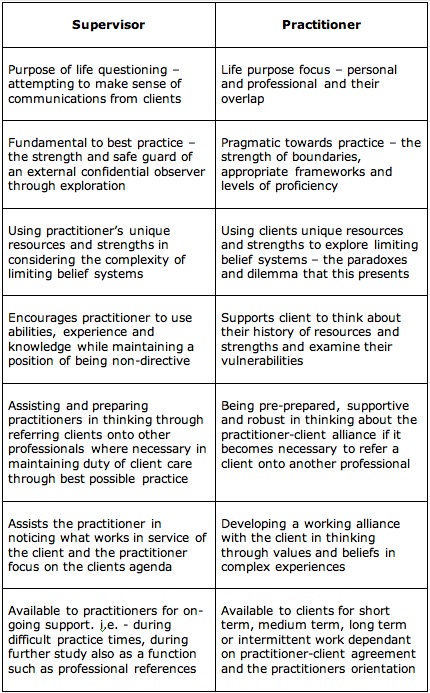Objectives of Practitioner Supervision
The main objective of Practitioner Supervision is to develop the practitioner's 'inner supervisor'. This requires the practitioner to engage in an on-going dialogue between theory and practice, and to evaluate if clinical experience might be essential to their mode of practice or not.
Relational ObservationOne theory is that a human being's primary motivation is to be in relationships with others. According to this view, the consequences of early relationships with primary care-givers will shape everyone's expectations about the way in which their needs are met throughout life. Although this is a vast and complex theory which clinicians are constantly investigating and commenting on, it may be useful for practitioners of all orientations to be open to thinking about the theory of object relating.
DevelopmentalWorking developmentally allows the practitioner to think about their clients' life-learning in relation to the developmental stages of the human life cycle. This can help the practitioner support the client in thinking about creating an environment in which the client can develop their full potential and lead a productive, creative life according to their needs goals. This objective is to get practitioners to think about how their clients make choices, and what motivates them.
Results-Based FrameworkPractitioners constantly discover that their clients find meaning and purpose in many ways. An objective of supervision is to consider how increased meaning and goal achievement meet with the clients' real experience. This objective enables the practitioner to monitor their own work in a results-based framework, which is external to the actual work with their client, in order to maintain a non-directive approach.
RestorativeOften, during their work with clients, practitioners find their clients beginning to achieve goals or experiencing proactive life changes. The challenge that practitioners face is finding ways of validating and honouring their clients outcomes without offering reassurance. Supervision assists practitioners in finding appropriate ways of acknowledging change. In turn, the supervisory relationship is the place where the practitioner can find validation of their good practice which cannot necessarily be found elsewhere.
PerspectiveWorking alone, or without supervision, can be like navigating a ship without a compass. While acknowledging that this is biased metaphor, perspective is necessary for practitioners to locate their position in their client-work. Supervision offers an alternative perspective which enables the practitioner to review or re-align their client-work.
Community of PracticeCommunity of practice refers to the process of learning and shared practices which emerge and develop when practitioners interact. This objective enables practitioners to connect by sharing their expertise and learning with other practitioners, thereby contributing to the knowledge of the collective practitioner base. It happens through communicating knowledge, and can potentially lead to new ways of practice, new abilities, and wider experiences.
The Value of the ThirdThe practitioner-client relationship forms a 'third' with the narrative that arises during their sessions; this is then afforded perspective and reflection when the supervisor-practitioner in turn form a 'thinking third' with the session material. This can be valuable in supporting the practitioner to relate to their client and considerations of what their client might be communicating.
Enhancing Practitioner ToolsTools which can be acquired through supervision:
Where to find advantageous theoretical material and resources
How and when to take a 'not-knowing' position
Engaging metaphor
Using scales to measure, mobilise, and develop progress
How and when to validate client progress
Working with and through challenging client sessions
The value of working integratively, and what this means
Developing a respectful and thoughtful position while following or challenging clients
Considering the developing practitioner's future
Comparison between Supervisor and Practitioner Objectives

